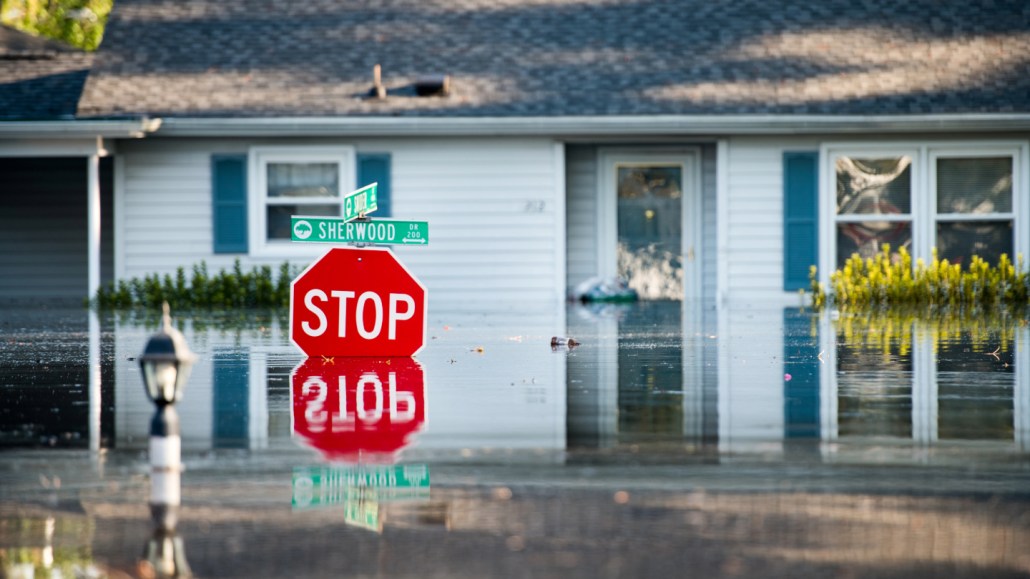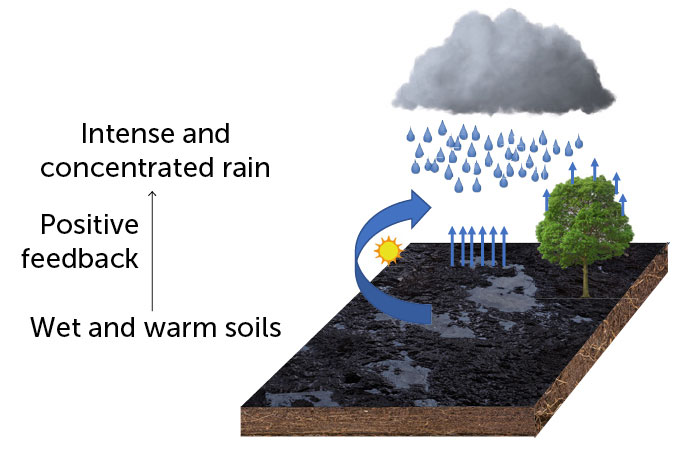
Hurricane Florence roared across the Carolinas in September 2018, gaining new intensity as it swept over already waterlogged soils. The resulting rainfall broke records, and floodwaters continued to inundate towns such as Conway, S.C., (shown) two weeks after the storm had passed.
Sean Rayford/Getty Images News
Once a hurricane makes landfall, it’s usually the beginning of the end for the storm. But a tropical cyclone passing over warm, waterlogged ground can get a jolt of energy that refuels its fury, researchers reported in January at the American Meteorological Society’s meeting in Baltimore.
This phenomenon, called the brown ocean effect, mimics how the ocean fuels tropical cyclones by giving the storms a ready supply of water and heat. Understanding this effect, researchers say, could help forecasters warn residents that an inland hurricane might counterintuitively strengthen.
Using satellite measurements of wind speeds, rainfall and soil moisture, geologist Dev Niyogi and colleagues examined how this effect was at play for Hurricane Florence, a relatively weak storm when it made landfall in the Carolinas in September 2018 (SN: 9/13/18). The data revealed a powerful feedback mechanism: As Florence passed over already-soaking soil, its rains intensified, ultimately leading to record-breaking rainfall and flooding.
It’s one of the first observational confirmations of this long-hypothesized phenomenon, says Niyogi, of the University of Texas at Austin. The brown ocean effect can also help some storms stay strong longer as they travel over land, he says, allowing them to penetrate deeper inland before dissipating (SN: 11/11/2020).
The idea of the brown ocean effect was described in 2013 by atmospheric scientist Marshall Shepherd and geographer Theresa Andersen, prompted in part by the very strange evolution of Tropical Storm Erin in 2007. The storm was weak and disorganized when it made landfall, but as it drifted northwest toward Oklahoma, it encountered flooded ground due to heavy rains that year. The storm suddenly strengthened, puzzling scientists as it even formed an eye for the first time.
Computer simulations have long suggested that wetter soils can intensify monsoon rains as well as cyclones. “Water evaporates from the ocean as water vapor, but when it gets into hurricanes, it condenses,” says Shepherd, of the University of Georgia in Athens. As the water changes from gas to liquid, it also releases heat — a jolt of storm-strengthening energy.
In Anderson’s dissertation work at the University of Georgia, she identified at least a dozen storms between 1997 and 2008, including Tropical Storm Erin, that were probably strengthened by this effect post-landfall.
And now, Shepherd says, there’s a growing body of scientific studies hunting for — and finding — the fingerprints of this effect in specific storms. “Tropical storms are not intelligent,” he says. “They don’t know the difference between wet soils, oceans and wetlands” as sources of energy.
The new study is among that body of work. Niyogi and colleagues used high-resolution satellite data on soil moisture, temperature and changes in rainfall before, during and after Hurricane Florence’s arrival on land. “As the storm system was moving, you could trace the source of moisture, see rainfall maxima,” Niyogi says.
The data revealed a powerful positive feedback between bursts of intense rain and soil moisture, the team found. How long the soils were wet before the storm passed over them also made a difference, they calculated: The heaviest rains occurred over soil that had already been saturated for about three days. That’s about how long evaporation from the soaked soil helped keep the atmosphere just above the ground nice and humid — ideal for feeding energy to a storm.

Saturated soil isn’t the only criterion — soil temperature was also key, the team determined. When the soil reaches a certain threshold temperature — one that’s yet to be determined, Niyogi says — the conditions are especially right to spin up a storm. The team’s findings were also reported in 2023 in Geophysical Research Letters.
Shepherd coauthored a separate study, also presented at the American Meteorological Society’s January meeting, that detailed how the effect contributed to flash floods inundating Texas during 2015’s Tropical Storm Bill.
And perhaps the most striking recent case of this effect came in 2021, when Hurricane Ida roared ashore in Louisiana, at almost the same location as 2005’s Hurricane Katrina. However, Ida lingered much longer before dissipating — probably fueled by days of rain soaking the ground and increasing the humidity ahead of its landfall, researchers reported in 2022 in the Bulletin of the American Meteorological Society.
What these data show, Niyogi says, is that “the brown ocean effect exists, if you look for it.”
Shepherd agrees: These studies confirm that the brown ocean effect “is real,” and that computer weather models need to incorporate the influence of land as well as ocean and atmosphere on tropical storms. That’s particularly important when it comes to forecasting the danger these storms might pose to inland residents, he says. “If a storm moves inland, the model needs to capture that there’s wet soil there.”







